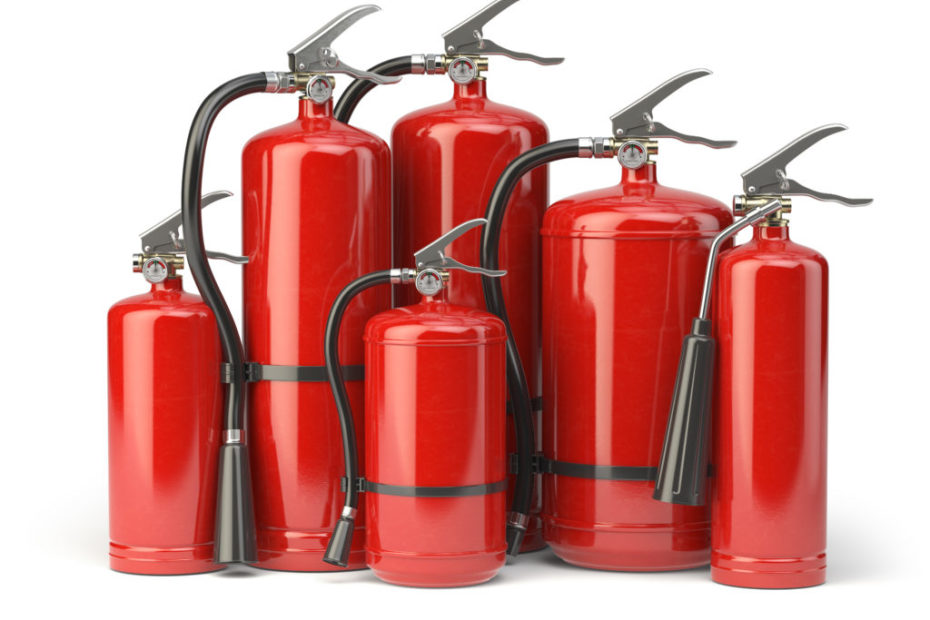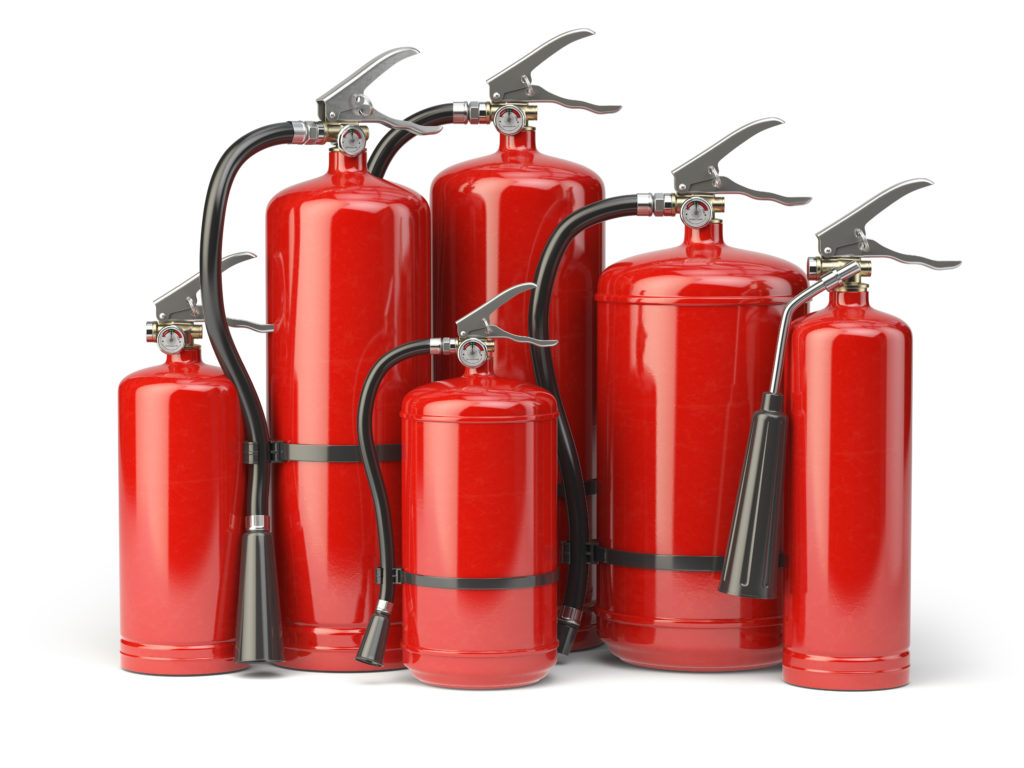Regular scheduled inspection and maintenance safeguard your Albuquerque business’ fire extinguishers are ready for use in an emergency.
For Albuquerque businesses fire extinguishers are the best defense it can have on hand to protect the company from small fires. Fire extinguishers need to be charged or pressurized fully to work well in the event of an emergency. It is a fact that many Albuquerque building owners accountable for regular fire extinguisher inspections, maintenance, and fire code compliance are uncertain when and how a fire extinguisher needs to be inspected and recharged. This guide offers the answers to those two requirements and it showcases the National Fire Protection Association’s (NFPA) scheduled maintenance intervals spelled out in NFPA 10: Standard for Portable Fire Extinguishers. NFPA 10 provides requirements to ensure that portable fire extinguishers will work as intended to provide a first line of defense against fires of limited size.
The guidelines for recharging fire extinguishers are as follows:
- Recharging fire extinguishers guide on what time and for what reason
- The step-by-step fire extinguisher recharging process.
- Making the choice regarding buying new fire extinguishers or recharging them.
If your Albuquerque business is thinking about buying new fire extinguishers, give us a call at 505-889-8999 for a free quote!
Fire extinguishers need to be recharged at regular intervals. Why is this required?
Logically you know your car will not continue to operate without performing regular routine maintenance on it during the life of the car.
The same logic goes for fire extinguishers. Like your car requiring regularly scheduled routine maintenance like oil changes and tune-up, your Albuquerque company’s fire extinguishers require regular routine maintenance for them to work during an emergency. T
The same principle applies to fire extinguishers. Just as your car needs routine maintenance, your fire extinguishers need upkeep to work as intended in an emergency. This maintenance includes everything from replacing the extinguishing agents that diminish over time or due to use, to disassembling and reassembling extinguishers to ensure every component is in working condition. Fire extinguisher maintenance includes taking apart and reassembling each unit to check that each part works properly, and recharging extinguishing agents in each unit, because over time the agent in units reduce or because a unit was discharged to extinguish a fire.
Albuquerque business’ fire extinguishers must be inspected on a scheduled basis to make certain each unit contains sufficient agent to stop a fire during an emergency.
Featured here are the set of events that each Albuquerque business most follow regarding recharging its fire extinguishers:
- Your Albuquerque business’ set of fire extinguishers have attained date set by the NFPA 10 for a hydrostatic test interval or internal examination.
- Your Albuquerque business used or discharged one or all of its fire extinguishers.
- It is discovered during an inspection that a fire extinguisher is low on agent or it is broken or not operational.
How do you know it is time to recharge a fire extinguisher?
Logically a fire extinguisher must be recharged after it has been used. It may have been used to stop a fire, used in an act of mischief, or discharged by mistake. In all instances the extinguishing agent must be recharged every time. NFPA mandates a fire extinguisher recharge must be done if an inspection indicates a problem or after any type of use, limited or not.
NFPA 10 mandates each month all business’ fire extinguishers must be inspected visually.
Inspection of a commercial property’s fire extinguishers may be required more frequently, particularly if historically it has had several fires, if the work setting indicates the business’ fire extinguishers are more likely to be damaged, such as a warehouse and the business is in a section of the city with more crime where fire extinguishers are damaged or taken regularly. There is a complete list of considerations listed on NFPA 10 to determine if more frequent fire extinguisher inspections should be administered by your Albuquerque business.
When these inspections are being done one of the most critical aspect to check is if the fire extinguisher’s pressure range is adequate. On the NFPA 10 it lists all the items that must be checked during a regular monthly inspection. If an issue is found during the inspection it must be addressed immediately.
During an inspection of a fire extinguisher’s pressure gauge, view the pressure needle’s location. When the needle is in the green zone on the pressure gauge, the units is pressured sufficiently, and manufacturer specifications have been met. The fire extinguisher pressure gauge features the correct pressure requirement for that unit.
A fire extinguisher needs to be recharged if the needle on the gauge is located outside of the green zone.
Annual maintenance is required for all Albuquerque fire extinguishers on top of a monthly visual inspection per NFPA regulations. Maintenance must also be performed when there is an issue or when a longer-interval hydrostatic test is mandated.
During annual fire extinguisher maintenance, the following tasks are completed on top of the itemized mandatory monthly inspection requirements.
- Examination of the outside of the unit to check for any apparent nozzle blockage, corrosion, or damage of any type.
- Pull the unit’s pin and take off the tamper seal to check for proper use. Put the tamper seal back right after this step is complete.
In addition to both fire extinguisher annual maintenance and monthly inspections, the NFPA 10 mandates set intervals for fire extinguisher required hydrostatic testing and internal inspection. The manner a fire extinguisher it stored, and its extinguishing agent type determine the testing and inspection intervals.
When a fire extinguisher is internal inspected, it is completely disassembled. From there the components are inspected and cleaned thoroughly and then reassembled and put back where it is stored for fire protection. The type of fire extinguisher dictates the interval that internal inspection must take place. Internal inspections can be from every year or only every six years.
NFPA 10 sets the intervals hydrostatic testing must be performed and this is determined by the extinguishing agent type in each fire extinguisher.
ABC dry chemical type is the most often employed fire extinguisher. This unit needs recharging and internal inspection 6 years after the date it was made and hydrostatic testing 12 years after it was made.
Albuquerque Fire Extinguisher Recharging
When your Albuquerque business’ fire extinguishers have been inspected and you figure they need to be recharged, it is best to call a fire extinguisher company like Brazas Fire to complete the service. The company will dispatch one of its trained technicians to recharge your units right there at your business or it will bring them back to the company’s shop, complete the recharge and any needed maintenance and then return your fire extinguishers and put them back where they are stored at your business for fire protection.
Not All Fire Extinguishers Need to be Recharged – Here is Why
There are single-use fire extinguishers. After discharge each of these units must be thrown out safely and a new one must be put into service. There are notable distinctions between rechargeable fire extinguishers and ones you can throw away after they are used.
Rechargeable fire extinguishers need to be replaced when the following is the case:
- Small fire extinguishers: Small fire extinguishers may cost less than what it will cost to have it recharged.
- Fire extinguisher shell wear and tear status: When the shell of a fire extinguisher is dented, frazzled, beat up, banged up, cracked in several places, or its label cannot be read.
- Fire extinguisher discharge hose or handle wear and tear status: If the discharge hose is cracked, ripped, clogged up or if the unit handle is loose.
- Fire extinguisher canister pressure lose issues: It is time to replace a fire extinguisher when the canister repeatedly loses its pressure.
When your Albuquerque business’ fire extinguishers are show any of the signs of wear and tear or they are not operating properly, and its time to buy new extinguishers, Brazas Fire is the place to call.
Fire extinguishers at your Albuquerque business need to be recharged after they have been inspected so they will operate during an emergency. NFPA 10 removes mistakes businesses can make when it comes to fire extinguisher inspection, maintenance, recharging, hydrostatic testing because it gives you the guidelines needed to keep your Albuquerque business safe if a fire were to occur. Brazas Fire is in business to help you make sure that is the case year-round.
Keep in mind the expense and fire extinguisher type when make the decision to recharge or to hydrostatically test. It may make more sense and cost less to buy new fire extinguishers instead.
Brazas Fire can sell or service virtually any fire extinguisher on the market today. Give the company a call at 505-889-8999 to ask any fire extinguisher questions you may have or to get a free quote to replace, inspect or recharge the fire extinguishers at your Albuquerque business.

